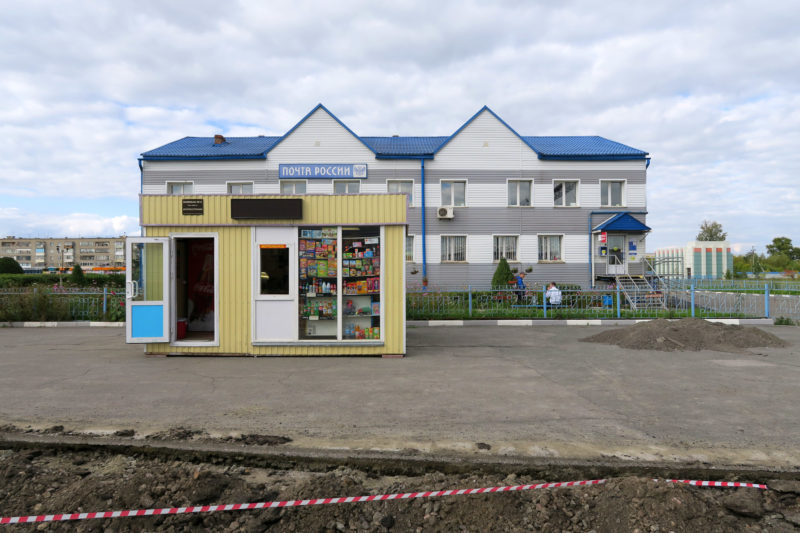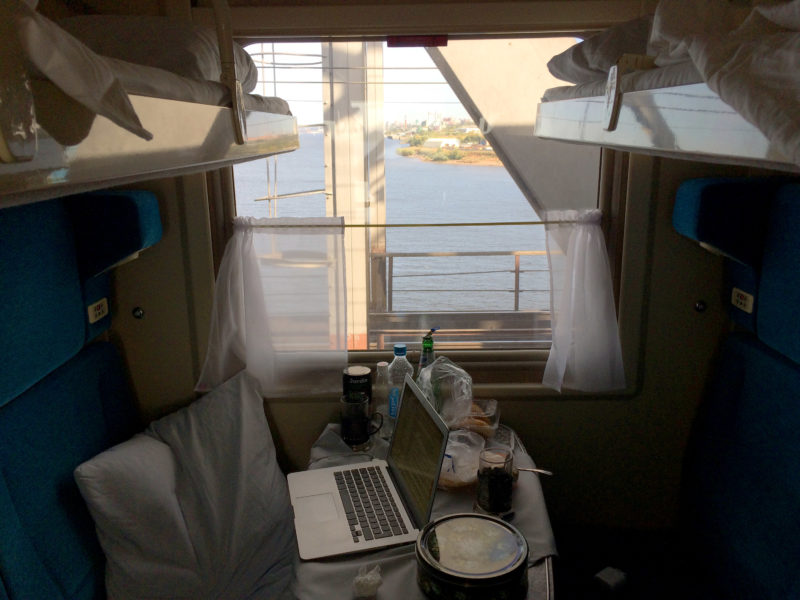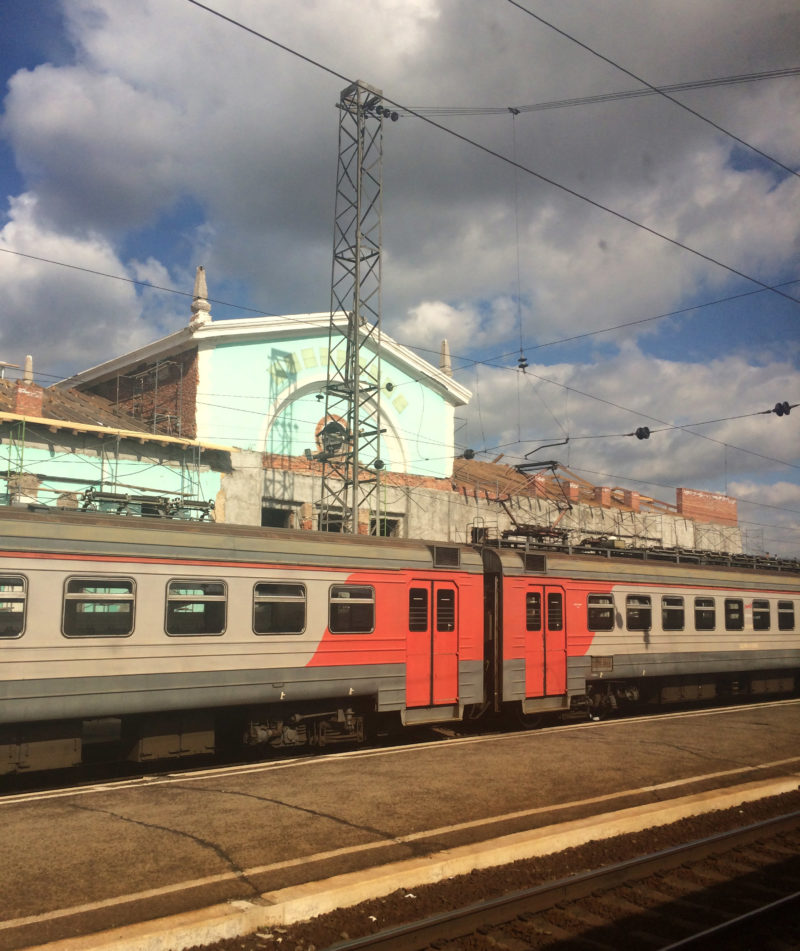21 Mar 2019
News
Slow travel through Russia – tips for the Trans-Siberian train

Photo by Miina Hujala and Arttu Merimaa.
Connecting Points is a program that aims at strengthening the collegial and curatorial activity in artistic and cultural realm in/within Finland and in Russia. The program is currently coordinated and curated by artist-curators Miina Hujala and Arttu Merimaa, who now share their tips on traveling by rails in Russia. Read their story below!
English version is followed by a translation in Finnish.
* * *
Since HIAP’s Connecting Points program is about exchange and connectivity, it involves a lot of travelling between Finland and Russia. Russia is the only country that one can enter from Finland with a direct passenger train access. Therefore, it seems very sensible to organize the travelling by rails. We see that it is our responsibility as coordinators of a residency program to consider the methods of travel from an environmental standpoint. This should be the premise of all activity in general. However, there are other aspects of this slower way of travelling that can become essential when trying to think about reorganizing our ways of moving and working, especially in the realm of art practices.
In Connecting Points, we try to consider the time and effort we use on travelling as tools for knowledge gathering – going from one location to another as a contemplative site-dependant transition, the shifting between places as a locus to pursue comprehension. Practically, the time you spend on the move can be used on reading, writing, drawing, discussing – or it may be not used at all: also just staying still is recommended. In this profession we (aim to) have the possibility to shape our relationship towards time and to the way we decide to spend it. Slowness is thus not a negative attribute.
Train travelling in Russia opens up routes towards Asia. In recent years, the residency collaborations between Finnish and Asian partners have become more frequent. In air travel Finland has also become a hub for routes towards China, Japan and Korea. For us it seems integral to develop less carbon heavy (neither train travelling in Russia nor different ferry routes in Asia are carbon neutral) methods of travelling that can also become a meaningful way for artists, curators, researchers, writers and thinkers to be “en route”.
We gathered some practical insights related to our previous trip from Moscow to Vladivostok.
We have done the train trip to Siberia only once leaving from Moscow, and then arriving at Vladivostok and travelling for 12 days (September 10 to 22, 2018). We stopped at Nizhny Novgorod, Krasnoyarsk, Irkutsk, and Ulan-Ude. We booked the train tickets through the travel agent Lähialuematkat, and using a travel agent is recommended, especially if one needs a visa for the travel. We also opted for more comfortable settings of having a cabin just for the two of us (our travel companions had to share one between three of them).
Usually one can reserve a place to a cabin of four or a place at an open car. Tickets can also be reserved directly from the website of Russian Railways. Hotels we reserved ourselves before online. It makes since to take at least 3 stops (we had usually one night per each, at Irkutsk two when we visited lake Baikal). This depends of course if one has time: at the schedule that we had, having four stops took almost two weeks.
Taxi apps (like Gett, Yandex or Maxim) and portable mobilewifi (like Megafon, Beeline, MTS or Tele2) help when stepping “off board” to the cities (these help find the hotels and navigate the city). At the train the mobile network – or any network – doesn’t function that well. In addition, electric sockets are as well a bit case-dependent since in some trains they were at the cabin and in one train the only one socket was found in the car, so we recommend taking a reserve battery with you. However, sheets were clean and the hot water was available in the samovar in the car.
Taking time, water and books is essential. The food you take with on the train is also a big thing. We recommended to bring with you:
– Instant-porridge
– Instant-noodles (are a russian train-institution)
– Wet sheets to clean up hands
– Tea / coffee (instant)
– Fruit
– Water
– Garbage bags
In addition, it makes sense to bring:
– Flip-flops that you can use on showers (that some trains have)
– Slippers that you can walk comfortably on the corridors and visit toilet (there are them on the trains)
If one is not fluent in Russian, translator apps might be helpful. Trains stop at the stations according to a schedule, usually for a couple of minutes, sometimes about 15-30 minutes. The schedule is viewable on the car or online (in Moscow time). During the stops one can go out and walk about a bit and purchase also some pies and such to eat (make sure to have cash with you on the train). Local ladies usually sell their produce outside the platform area. There is a restaurant car on the train, of which the style, atmosphere and menu varies (we prefer the more nostalgic ones, of course).
The real luxury is the time, the abundance of it, and the possibility to be at peace. When one sits on a train for three days, but still moves forward (on route to somewhere) one gets time to process, the experiences as well as what one reads, and what one thinks. The stops are important for the change in rhythm and to relax in a different way. During our visits in the cities we always checked a local museum and then just went to eat somewhere. We didn’t draft any particular programme and it worked well when things weren’t so precise. The main thing was that this was a way to do the trip, a very long one geographically though, and not be ‘touring’ in the sense of as in tourism. The difference is that this is a way to make a trip, through places and between them, not only to a place. In a project that we are starting to organize, relating to train travelling and residency activity, we will focus just on this. The travelling as durational.
The project is centered around moving by train, in a time when the need to question the transport done through fossil fuels and the need to find solutions related to climate change is acute. Travelling as an essential part related to residency activity and bringing people together has been a tool in creating real contacts, communication and distributing knowledge, as well as enabling shared meetings and formulation of shared views together with a professional field. The residency activity is then a way to open and form new connections in where long distances traversed through train or by ferry makes it visible, and then also strengthens, the importance of making practical measures in the usage of methods of transportation and routes sustainably climate-wise.
We noticed (some of the members of the group at least said they agreed) that we liked the fact that we could be on the train. Our pre-condition was that we would have had a difficulties in returning to the train after being there for three days consecutively – but you noticed that you somewhat waited for that as well. We have yet to do a two-way journey (trip back as well), but we think that one needs to be longer on one spot after, coming back immediately might seem too much, but we haven’t done the trip back in one go either – yet (which would take about seven days). We are aiming to use the train as a transport method towards Asia (Japan, Korea and well as China) when part of the trip would be done by ferry. Our intention is then to add the duration, and make also cultural connections a bit more durational and deeper. In tourism the short excursions to relax won’t always benefit the local economies the best way, and in some instances the multinational chain corporations benefit the most from it.
For us travelling is also connected to the work we do, and through it we aim to observe how it is a part of our professional and global collaboration network. We therefore ask: What can a residency practice provide as a means of connection between places as well as a way or working artistically? What does moving between places mean in connected to this, and how options for travelling can pay attention to the environmental and climate effects and in an integral way support the practice?
These questions we wish that every kind of organization would think in relation to the travelling related to working.
Miina Hujala and Arttu Merimaa

Photo by Miina Hujala and Arttu Merimaa.
Suomeksi / In Finnish:
Olemme tehneet Trans-Siperian junamatkan vain kerran, matkustaen silloin 12 vuorokautta (10.9.-22.9.2018) lähtien Moskovasta ja pysähtyen Nizni Novgorodissa, Krasnojarskissa, Irkutskissa ja Ulan-Udessa. Me varasimme matkat matkatoimiston kautta. Me käytimme Lähialuematkoja, muitakin matkatoimistoja on toki. Matkatoimiston käyttöä suosittelemme, varsinkin jos tarvitsee viisumin myös matkalle. Me myös halusimme hieman mukavammat ja rauhaisammat oltavat ja otimme hytin vain kahdelle hengelle (matkakumppanimme joutuivat jakamaan hytin kolmestaan).
Yleensä saa paikan joko neljän hengen hyttiin, tai sitten voi ottaa paikan avovaunusta, jossa on oma sänky. Liput voi varata myös suoraan verkosta Venäjän rautateiden sivustolta. Hotellit varasimme itse netissä etukäteen. Kannattaa ottaa ainakin kolme pysähdystä (me olimme suunnilleen yhden yön jokaisessa kaupungissa, Irkutskissa yövyttiin kaksi, kun käytiin myös Baikal-järvellä). Riippuu siis jos on aikaa: matka jossa oli neljä pysähdystä kesti jo miltei kaksi viikkoa.
Taksisovellukset (kuten Gett, Yandex tai Maxim) ja mobiiliverkko (kuten Megafon, Beeline, MTS tai Tele2) helpottavat hieman “maihinnousuja” kaupunkeihin (suunnistusta hotelleihin ja kaupungeissa). Junassa mobiiliverkko – tai mikään muu verkko – ei oikein toimi. Töpselitkin ovat hieman juna-kohtaisia: joissain löytyi hytistä hyvin, kun taas yhdessä junassa oli vaan käytävällä yksi töpseli, joten suosittelemme ottamaan vara-akun mukaan. Lakanat ovat kuitenkin puhtaat ja kuumaa vettä saa junavaunun samovaarista.
Ota aikaa, kirjoja ja vettä. Eväät on myös iso juttu. Suosittelemme ottamaan mukaan:
– Pika-kaurapuuro
– Pika-nuudeli
– Käsien pesupyyhkeitä
– Teetä / kahvia (pikakahvi)
– Hedelmiä
– Vettä
– Roskapusseja
Mukaan kannattaa ottaa myös:
– Vettä kestävät tossut (jos haluaa käydä suihkussa joka joissain junissa on)
– Tossut joilla voi kuljeskella mukavasti käytävällä ja käydä wc:ssä (joita junissa on)
Jos venäjää ei osaa edes auttavasti niin käännössovelluksista voi olla apua. Junat pysähtelevät tietyn aikataulun mukaan asemilla yleensä noin 15-30 minuuttia jolloin voi mennä jaloittelemaan ja ostamaan purtavaa. Käteistä tarvitsee mukaan ja voi katsoa aina näkyykö paikallisia rouvia myymässä piirakoita ynnä muuta – heidät on “siirretty” hieman syrjemmälle itse laiturialueelta, mutta ovat yleensä paikalla myytävineen. Pysähdysten aikataulut ovat nähtävillä junassa (kaikki Moskovan ajassa) ja ne voi myös tarkastaa netistä. Ravintola-vaunu löytyy jokaisesta junasta, mutta niiden tyyli, tunnelma ja tarjonta vaihtelee (itse pidämme tietysti enemmän niistä hieman nostalgisista).
Todellinen luksus matkalla on aika: sitä riittää ja sen kanssa saa olla ihan rauhassa. Kun istuu junassa kolme vuorokautta, mutta silti liikkuu eteenpäin (on matkalla jonnekin) niin saa myös aikaa sulatella, niin kokemuksia kuin myös lukemistaan, ja ajatella ajatuksiaan. Pysähtymiset ovat tärkeitä, sillä silloin saa vähän vaihtaa rytmiä, ja rentoutua hieman eri tavalla. Me kävimme kaikissa kaupungeissa katsomassa jonkun paikallisen museon ja ruokailimme jälkeenpäin. Emme tehneet sen enempää suunnitelmia ja meille toimi hyvin aikatauluton ohjelma. Pääasia on että tämä on väylä tehdä matka, tosin melko pitkä maantieteellisesti ja siten ei niinkään ‘matkailla’. Ero on siinä että kyseessä on tapa tehdä matka, paikkojen kautta ja välillä. Ei vain paikkaan.
Hankkeessamme, jota alamme organisoida liittyen junamatkailuun ja residenssitoimintaan, keskitymme juuri tähän. Matkailuun kestollisena. Hanketta keskittää liikkuminen junalla, joka kyseenalaistaa fossiilisille polttoaineille perustuvaa liikkumista aikana jolloin ilmastonmuutokseen liittyvien ratkaisujen tarve on akuutti. Residenssitoimintaan oleellisesti liittyvä matkustaminen ja ihmisten saattaminen yhteen on ollut väline aitojen kontaktien luomiselle, vuorovaikutuksen ja tiedon välittämiselle, sekä jaettujen kohtaamisten ja näkemysten muodostamiselle yhdessä ammattikentän sisällä sekä myös erilaisten paikkojen ja ympäristöihin kiinnittyvien merkitysten kanssa. Residenssitoiminta voi siten toimia myös väylänä avata ja muodostaa uusia yhteyksiä, jossa pitkien välimatkojen ja etäisyyksien taittaminen junalla ja lautalla tekee näkyväksi, ja siten myös vahvistaa, käytännön tekoihin liittyvää tärkeyttä ilmastollisesti kestävien liikkumisvälineiden ja väylien hyödyntämiselle.
Huomasimme ryhmän kanssa, että pidimme yllättäen siitä että saimme olla junassa. Ennakko-odotuksemme oli ollut, että olisi ollut hankalaa palata takaisin junaan ja asennoitua taas uudestaan kolmen vuorokauden matkalla oloon – mutta sitä jotenkin myös odotti. Vielä emme ole tehneet matkaa myös takaisinpäin, ja uskon, että sen suhteen tulisi paikan päällä olla kohteessa hieman kauemmin, muutoin matkasta tulee melko raskas, mutta emme myöskään ole vielä menneet sitä edestakaisin yhtäkestoisesti (eli noin 7 vuorokaudessa). Meillä on tarkoituksena käyttää junaa matkaillessamme Aasiaan (erityisesti Japaniin ja Koreaan, sekä Kiinaan) jolloin osa matkasta täytyy tehdä lautalla. Meitä kiinnostaa lisätä matkalla olemiseen liittyviä kestoja, ja tehdä siten myös kulttuurillisia yhteyksiä myös kestävimmiksi ja syvällisimmiksi. Turismissa pyrähdykset rentoutumaan eivät aina tue paikallisia talouksia kaikkein parhaimmalla tavalla, ja monissa paikoissa turismista hyötyy eniten isot monikansalliset ketjut.
Meille matkailu liittyy myös työhömme, ja sen kautta pyrimmekin sitä tarkastelemaan osana nykyajan ammatillista ja globaalia yhteistyöverkostoa. Kysymme siis: Mitä residenssitoiminta voi tarjota eri paikkoja yhdistävänä yhteistoiminnan ja taiteellisen työskentelyn muotona? Mitä tarkoittaa tähän liittyvä liikkuminen eri paikkojen välillä ja miten ympäristö- ja ilmastovaikutukset huomioivan matkustamisen eri vaihtoehdot ja muodot voivat tukea olennaisella tavalla tätä toimintaa?
Näitä kysymyksiä toivoisi minkä tahansa organisaation miettivän osana työntekemiseen liittyvää matkustamista.
Miina Hujala ja Arttu Merimaa

Photo by Miina Hujala and Arttu Merimaa.
